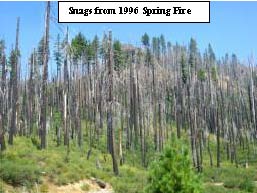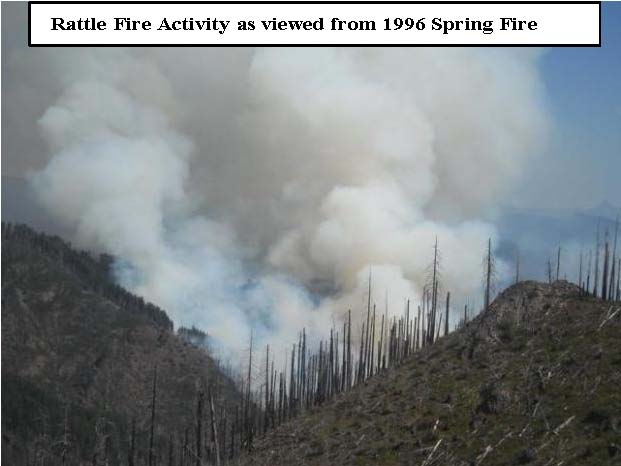- April 14-16, 2017
(8:00 am Fri. - 5:00 pm Sun.)
Bull Run Snag Incident — August, 2009
|
HRO Review of the Rattle Fire Snag Incident
September 10, 2008
(download PDF report, 11 pages, 345 kb)
<<< read previous — Rattle Fire Snag Incident,
Introduction >>>
In Their Own Words: IHC-1
On August 23, 2008, we were assigned to the Rattle Fire on the Umpqua National Forest in the Boulder Creek Wilderness. The fire was approximately 200 acres burning in a remote area inside the 1996 Spring Fire. At the time, IMT2-1 was managing the North Fork Fire on the North Umpqua RD and took over management of the Rattle Fire. Due to the location of the fire in steep, rugged terrain, and the extreme hazards posed by the burned snags that were still standing from the 1996 burn, the decision was made (by the team and the Forest) to construct indirect line to lessen the exposure of firefighters to the threat of the snags.
 There were numerous IHC crews and professional timber fallers on the fire prepping and snagging the roads around the Boulder Creek Wilderness. After watching the fallers work and talking to them it was apparent that the snags they were felling from the 1996 burn were extremely hazardous. The snags were very large in diameter, most had broken tops and were rotten from one quarter of the way up from the base. Many of the trees broke apart in mid-air as they were falling after being cut. After talking with a number of the fallers about the situation it was clear that nobody was really comfortable with having to fall the number of trees that was required along the road due to the hazardous condition of the snags. There were numerous IHC crews and professional timber fallers on the fire prepping and snagging the roads around the Boulder Creek Wilderness. After watching the fallers work and talking to them it was apparent that the snags they were felling from the 1996 burn were extremely hazardous. The snags were very large in diameter, most had broken tops and were rotten from one quarter of the way up from the base. Many of the trees broke apart in mid-air as they were falling after being cut. After talking with a number of the fallers about the situation it was clear that nobody was really comfortable with having to fall the number of trees that was required along the road due to the hazardous condition of the snags.
As IMT2-1 timed out the fire was transitioned to another Type 2 IMT (IMT2-2). We took two days off and were reassigned the Rattle Fire when we became available. Our assignment was to hold until the fire reached set trigger points: we would then burn out roads and handlines that had been established with the previous team. It was brought to my attention that the current team had a group of rappellers working inside the Boulder Creek Wilderness on the Boulder Creek Trail. This trail had not been maintained since the 1996 fire and was mostly within the boundaries of the burn scar from 1996. The area was covered in snags. The Boulder Creek Wilderness is known for rugged terrain and is composed of sharp ridges and steep drainages. There were only a couple of locations with the ability to land a Medivac if there was a need. When we asked what the Rappellers were doing in there we were told they were opening the trail for a control line. The amount of unmanaged risk exposure due to the snag hazard and lack of places for medivac sites in the area concerned me.
On September 5, the fire had transitioned again, this time to a Type III organization (ICT3-2) and plans for the fire changed again. Work was stopped on the Boulder Creek Trail due to the hazards involved, including lack of good safety zones, escape routes, and snags. My crew was instructed to hike into Pine Bench and monitor the fire across Boulder Creek. We hiked in and arrived at Pine Bench which had also burned in 1996 Spring Fire. On the northern end of Pine Bench there were numerous snags left from the Spring Fire. There was a falling module with us and we assessed the area that the crew would be monitoring from and had the fallers remove some of the more hazardous snags. Fire activity was moderate that day, backing down into Boulder Creek. We were utilizing Type 1 helicopters to slow the spread and keep the fire from crossing the Boulder Creek drainage. I had a short squad hike up the trail to keep an eye on another area where the fire was backing down and work helicopters as needed. At this time I saw the work the rappellers had done on the trail. It had been reopened and cut out, but none of the snag s had been removed.

That afternoon, as fire activity started to pick up, I walked up the trail with the Task Force Leader assigned to us. One of our squad bosses on the trail north of us called and said they had a spot fire across Boulder Creek. It was below the trail and burning actively in the brush and deadfall. By the time the TFLD and I arrived at their location I could see at least 7-10 spots above and below the trail that were burning very actively. There were at least six snags that had fire in the tops of them. I pulled the crew out and we tried to get the Type 1 helicopters in to cool them down. We moved the rest of the crew up the trail to assist the short squad as needed. It quickly became apparent there was nothing we would be able to do with the current fire behavior, steepness of the slope, and the amount of burning snags. We backed off and observed the fire as it started moving in a SE direction towards Highway 138. The wind was blowing from the NW 5-15 mph. Myself, one squad boss, and the TFLD were standing on the trail in a snag patch and the crew was back down the trail to the south. The crew called and said that with the wind coming up they had three tops come out of snags and land very near them. They asked if they could pull back to Pine Bench where there was a large opening. As the TFLD and I watched the fire moving south a limb or top came out of a snag barely missing the TFLD head and shoulder and hit the ground missing his boot by less than 2 inches. The top was about 8 inches in diameter and 16 inches long. At this point we all hustled out to Pine Bench and to the highway. The fire had made about a one mile run and spotted across the North Umpqua River and Highway 138.
Due to the complexity, a new Type II management team was ordered (IMT2-3) and took over the fire two days later. On September 10, we were assigned to swing shift in order to conduct burnout operations as needed. We were assigned to Division A on our first shift. At 1245 I contacted Division A supervisor by radio where he instructed us to go to Pine Bench and construct handline downhill from Pine Bench to the road we were parked on. The weather that day showed possible winds from the NE 5-15 mph. Having had near misses on Pine Bench with snags coming down in the same conditions five days earlier, I had some concerns. I relayed my concerns over the radio to the division supervisor. There was already an IHC crew coming down from Pine Bench, so I instructed my crew to anchor off the road and build line uphill. Myself and one squad boss proceeded up the trail to Pine Bench.
I met the Division A supervisor on the trail where the other IHC crew had come down with their handline and crossed the trail. He briefed me on the plan to construct line across Pine Bench to the road at the bottom and burn it out that day. His intention was to complete the burnout that shift due to another burn operation planned on the other side of Division A the following day. It was almost 1400 and the plan was to start the burnout by 1730. He explained that we were to anchor handline into a rock outcropping above Boulder Creek, bring it across Pine Bench and down to the road. At this time I relayed my concerns about the old snags on Pine Bench. I told him that from halfway up the trees were rotten, soft, and weak and that we had several close calls previously in the area with tops falling out in the wind. I told him we had been on the fire for almost three weeks and even professional fallers had concerns about the threat these snags posed to crews working around them.
My squad boss and I scouted the proposed line placement and reviewed the plan for burnout operations on Pine Bench. There was one stretch of the proposed line that went through a large section of old snags from the Spring Fire. There was very little to no fire activity on Pine Bench at the time and a small amount of active fire in a snag patch on the north end of the bench. There was also a small active piece on the south end of the bench where the handline came up from the bottom. The rest of the bench was cold. I decided that I would rather have my crew working on the handline from the bottom up to Pine Bench rather then working in the old snags. We still did not have a good anchor point for our lines and I felt the priority was to get the line tied in from the road up to Pine Bench with IHC-3 and get that secured. I knew IHC-2 would be arriving shortly and they could bump to the top to do the line on Pine Bench.
IHC-2 arrived shortly after and briefed with the division supervisor, TFLD, IHC-3, and myself. IHC-2 decided to go with Division A and the TFLD to scout out Pine Bench for the line placement. I had talked to the superintendent of IHC-3 and indicated the snag hazards, but when IHC-2 and Division A returned and we all briefed again, I didn’t voice my concerns. I had indicated to IHC-2 several days before on another part of the fire about working in the area of the Spring Fire due to the conditions the snags were in. As the group split up, my squad boss and I headed back towards the crew and were monitoring some snags burning above them.
Our handline tied into Pine Bench around 1800 and we were getting ready to burn out. At about 1900 we were ready to burn when a call came over the radio that a Medivac ship was needed on Pine Bench immediately for an extraction; someone had been hit by a snag. After confirming with my crew that all of our people were accounted for, I pulled them off the line to secure their locations, told them to keep radio chatter to a minimum, and sent our EMT’s to see if they were needed to assist. We helped clear the path to the evacuation site and assisted with handling the patient.
<<< continue
reading — Rattle Fire Snag Incident,
Incident Day >>>
|
